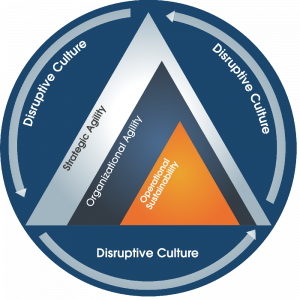At the Institute for Digital Transformation, we are focused on studying the impact on organizations and their leaders as we transition from the Industrial Era into what we call the Digital Era. In its simplest form, therefore, we believe a Digital Enterprise is an organization that has completed this transition. But the result of that transformation is an organization that looks very different from today’s typical organizations.
Modern enterprise organizations are vestiges of the Industrial Era. They were created, built and organized in and for a different time. This includes the physical and logical manifestations of our enterprise organizations: buildings, capital investments, organizational structures, policies and procedures and, bluntly, most everything about how the typical enterprise organization works. But more importantly, it also includes the very essence of our organizations: their culture.
Culture is why most digital transformation efforts fail. A successful digital transformation is not, in fact, a technology-driven endeavor. It is first and foremost a cultural and organizational transformation. Digital technology, such as video streaming and the internet of things, are merely the catalysts and then ultimately, the product.
More than that, however, an effective digital transformation should not be undertaken to develop a specific “digital capability,” but rather should be focused on developing a “cultural capability” that will ready the organization for the unique pressures and demands of the digital era – an agile organization.
The digital era will place demands on enterprises that will run counter to most of the well understood operating paradigms of the past. Multi-year planning cycles are being replaced with dynamic strategies. Product cycles, both in terms of development, as well as in terms of marketability, have shortened dramatically. Competitors are emerging at a more rapid rate and from unforeseen quarters as barriers to entry fall. Most industries are seeing these things happen right now.
Driving the transformation of an organization into a Digital Enterprise is a significant effort. It will require that you address virtually every aspect of your operating business model: organizational structure, business processes, operational functions and, of course, technology strategy.
Those organizations that are successfully making this transition are doing so by developing four specific cultural capabilities that we deem the Digital Enterprise Readiness Framework:

- Operational Sustainability
- Organizational Agility
- Strategic Agility
- A Disruptive Culture
The road to being a “digital ready” enterprise starts at the operational level. That may sound counterintuitive, but an organization cannot begin to think about successfully executing a digital transformation without a sound base of organizational discipline. After sound, operational discipline is established in the culture, the organization must address organizational agility, strategic agility and finally, the organization must have a disruptive culture. These are the “dimensions” of the Framework.
Operational Sustainability does not necessarily equate to the highest levels of operational maturity or completely robust process definitions and operations. Rather it means the organization is operating efficiently with repeatable processes. The organization accepts “just enough” process or what is adequate as opposed to optimizing.
Organizational Agility is not just about the ability to change direction. It is the ability to rapidly adjust the structure, operating processes and/or functions of your organization to adapt to changing market conditions. It demands that organizations and their leadership can reduce structure and process, as necessary to enable the organization to respond more rapidly and effectively.
Strategic Agility is the ability to know when to pivot, whereas Organizational Agility is about the organization’s ability to pivot when directed. Organizations must reduce their reliance on long-term strategic planning and instead create the capability within the organization to continuously monitor shifts in the market and emerging technologies. They must dynamically shift the organization’s strategic direction and vision to create competitive advantage and mitigate competitive disruption. It is about rapidly recognizing your external threats and internal weaknesses and exploiting external opportunities and internal strengths.
Disruptive Culture is willingness to challenge the status quo, embrace innovation, experimentation and “fast failure” and which is perpetually focused on what’s coming next. The culture must permit continual disruption in every facet of the organization, including: technology, business models, industry dynamics, offshoring and outsourcing strategies, regulatory management, etc. It must do it in a constructive and not destructive way.
These four dimensions are the building blocks of readiness, ensuring that your organization has the necessary combination of stability, agility and an openness to change in order to complete the transformation into a Digital Enterprise. The Framework defines specific attributes within each dimension that are indicative of readiness.
These attributes have then been converted into a data model, which enables you to objectively assess your readiness, identify areas that may inhibit transformational efforts and then track your progress.
Institute for Digital Transformation has developed the Digital Enterprise Readiness Assessment based on this Framework. Each of the four dimensions is broken down into attributes and characteristics which can be measured. The data is then analyzed to determine whether they are Not Ready, Preparing, or Ready to success in a Digital Transformation.
About the Author:






Trackbacks/Pingbacks